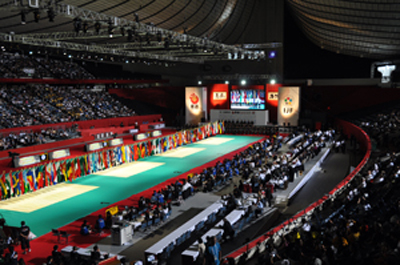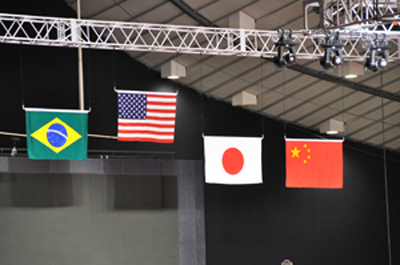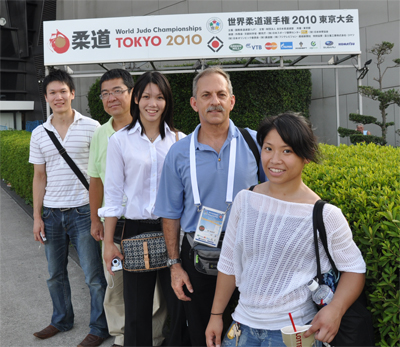I’m back from the World Championships in Tokyo. It was a good trip, but for the first time ever jet lag is kicking my butt big time. It’s been a week since I returned to San Diego and I still can’t sleep. I might have to buy some valerian today to see if that helps.
I gathered so much information that my report on the Worlds will be in several parts. The first part will be devoted to the officiating and rules. With all the recent rule changes, I was looking forward to seeing what Judo would look like at the international level. I was in for a surprise, and a good one at that.
My first overall impression was that what we had been told at the local level was not what was going on at the international level. That’s really no surprise considering that rules mutate like a virus from World Cup to World Cup. These changes are so frequent that there is not enough time for them to filter down to us lowly peons.
The second impression I had was that the IJF referee commission had given the referees at the World Championships new marching orders. To corroborate this, I called Robert Fukuda, the American referee at the 2010 Worlds. He confirmed that after the first day the IJF commission told the referees they were issuing too many penalties, and that they should allow the players to decide the outcome of the matches. And for the most part that is exactly what happened. With just a few exceptions, players were allowed to dictate the outcome of the matches, and shidos were not invoked to terminate a match early.
Now to the particulars. Many of the rule changes that have been made in the last 4-5 years have been relaxed or are completely being ignored. The notion that players have to get a classical grip within five seconds was nowhere to be found. Opposite side one handed-lapel grips well beyond the five-second time limit were allowed with impunity. Gripping was so furious that few gripping infractions were called. The only infractions that I saw were for two hands on one side.
I thought that throws with a forward aerial somersault had been banned a few years back. Apparently this may no longer be true. World Champion Kayla Harrison (USA) used one to win by ippon. Can we now go back to standing Kata guruma with a forward somersault?
The rule against leg grabs was very relaxed. Although there were many grabs or attempts to grab, I only saw two players receive hansoku make. In his first match, Beijing Olympics silver medalist Darbelet (France) was one of the penalized players. Unfortunately, I didn’t see the actual act since it’s hard to monitor four mats at one time, but clearly anything other than a direct grab was allowed. So combinations and counters using a leg grab as a second technique were not penalized regardless of the “intent” of the player. Body contact did not seem to be a criterion like we were initially told. Someone please pass this on to local American referees!
Soft ippons continue to plague Judo. In a semi-final match, Suzuki (Japan) defended against a forward attack by kneeling down. After a few seconds he was pushed onto his back and his opponent scored ippon. Referees continue to tell me that it’s always been like that. I am getting old and my memory isn’t what it used to be, but I know darn well that soft ippons are a recent invention of modern refereeing. And, lo and behold, the organizers of the Tokyo World Championships provided me with proof of that. During intermissions, matches from previous World Championships and Olympics dating back as far as 1971-72 were shown on the big screen. What is clear is that uke had to be standing, and slammed hard and flat onto his back to score ippon. There was none of that “rolling, soft garbage from knees with back barely on the mat” that now merits ippon. As a matter of fact, I was surprised by the number of koka and yuko scores given for good, hard throws back in the 70s. So there is no illusion, and I am not in the early stage of dementia. Ippon has been devalued over the years, and we should ask ourselves how this benefits our sport. Members of the IJF referee commission might want to review these older fights and rediscover what ippon once was.
Lack of appreciation for ne waza was readily apparent. Too many ne waza skills were thwarted by early, misplaced matte calls. Knowing that little time will be allowed for ne waza, many players don’t even bother anymore, although they may wind up in an excellent transition to ne waza. Why waste energy?
To keep the match flowing, gi jackets were allowed to come out of the belt for extended periods. On the other hand, matte continues to be used excessively for no apparent reason in transitional situations. Getting up from a ne waza situation should not be interfered with a matte call. Change of location (height) is part of fighting.
The dynamic edge was abused much too often. Players were constantly walking out of bounds in the absence of Judo, and with impunity. Eventually on day 4 and 5, more referees issued shidos for stepping out. This inconsistency in enforcing the rule from day one caused Lebrun (France) to lose in Golden Score to Sugimoto (Japan) in the semi-finals of the Open category. Lebrun stepped out slightly and was given a shido. As often occurs in Judo, this came totally out of the blue for no apparent reason. On the other hand, blatant crawling out of bounds on all fours from ne waza, as Monteiro (Portugal) did against Matsumoto (Japan) during the 57 kg finals, was allowed to continue throughout the entire match because apparently it’s OK to flee the fighting arena in ne waza, but not kosher to step out in tachi waza. There’s no logic to this. In spite of not being a fan of penalties, I firmly believe this act should be punished.
As anticipated, far too many matches ended with nothing but shidos. This is troubling. Judo’s scoring system must be revamped to reward positive Judo, while minimizing the weight given to negative Judo.
Despite the fact that rules are not supposed to change in the middle of a quadrennial, a new change was confirmed at the Worlds. The frontal bear hug (essentially a frontal Ura nage or wrestling suplex) that Hashbaatar (Mongolia) uses with great success has been banned because the referee commission claims it’s not a Judo throw! Didn’t Kano borrow from other arts, including wrestling (Kata guruma!), when he formulated Judo? And haven’t Sambo and folk wrestling techniques already made their way to our inventory of Judo-useable skills? Why the sudden act of purification? The sad part is that, like the standing Kata guruma variations that were banned a few years ago, Hashbaatar’s throw is the type the IJF wants spectators to view: high amplitude, dynamic, exciting, and spectator rousing. Makes no sense to ban it.
Finally, the replay system was used to assist the three referees. Yes, you heard it right. Three referees, not one, as we had been told. I guess it didn’t take long to figure out that if three referees have a hard time getting it right, how could one referee do a better job than three? While the right person won most of the time, no video recording system can guarantee that the right player will win all the time. Subjectivity is still part of Judo, and it showed in the Open category final. Riner (France) came closest to scoring in his match against Kamikawa (Japan) yet lost a hantei decision after a scoreless Golden Score in which he was knocked down to his stomach three times, but was never close to being scored on. On top of that, Kamikawa had earned a shido. Go figure. Before the winner was announced, I called it right. I sensed that Kamikawa would win on split flags thanks to knocking Riner to his stomach three times in the last minute, which is apparently what two out of the three referees remembered.




Gerald:
I accept your general point about the tendency to over-penalise but, in my opinion, Kamikama should have received another shido – for passivity – before golden score. That passivity was a (passively) defensive reaction to Riner’s more dangerous judo. Then, the fighters would have decided the outcome and not the officials via flags.
I look forward to parts 2 etc and hope the jetlag has receded.
In Tokyo, based on our current “penalize the players” culture, lots of players should have received shidos. They didn’t because the IJF decided to minimize such penalties. Even I was surprised at how far the pendulum has swung. I grant you that it will take time to adjust to this culture if this is where the IJF is heading. We must devise a scoring system that doesn’t create world champions based on one player receiving one less penalty than the other.
By the way, melatonin and valerian did the trick as far as the jet lag is concerned.
I hope these rule changes filter down to the local level, STAT! Alot of the local tournaments I see are still at the point of “enter, get any grip possible, drop to knees, penalize the other player for not doing the same.”
Thanks for this. Interesting that the officiating was lenient, in a good way. Looking forward to future posts.
This reports makes me feel like I was right there…thanks.
Great reporting Gerry! Your commentary is right on the money.
Pingback: JudoNotes » Blog Archive » Lex Fridman's blog